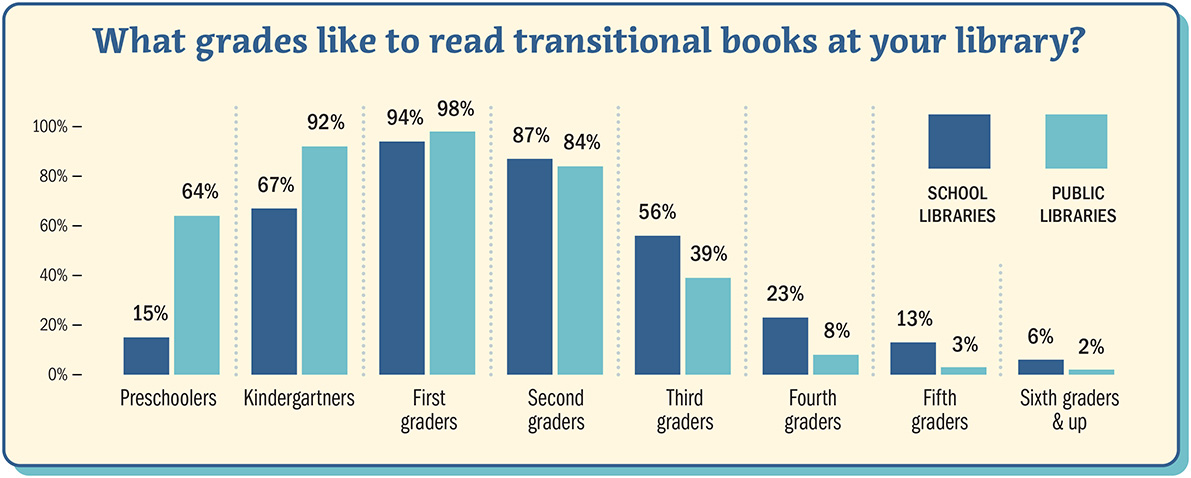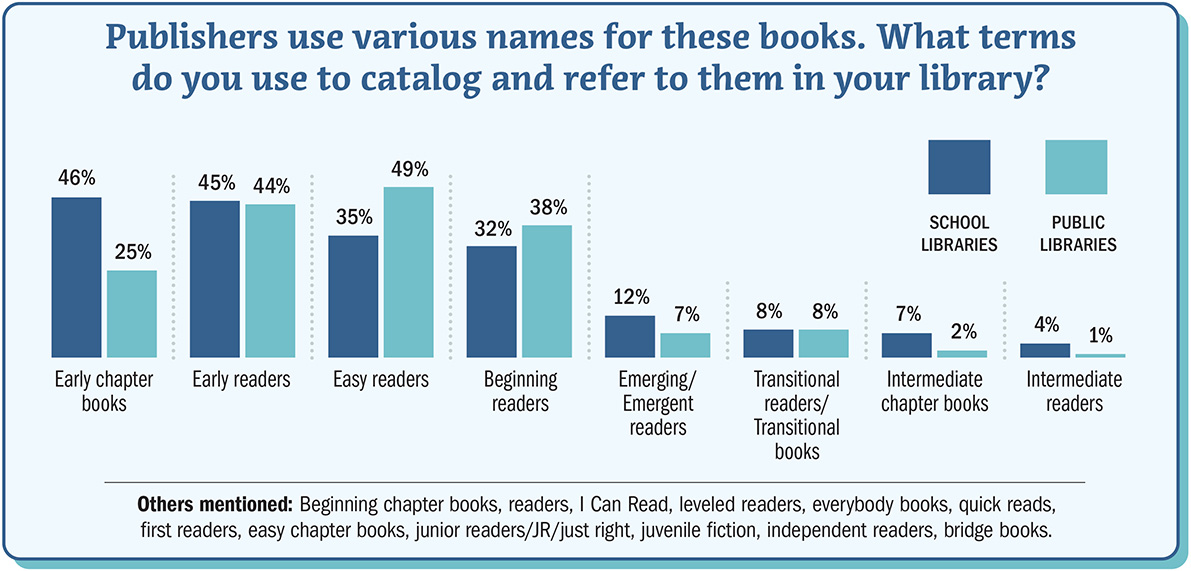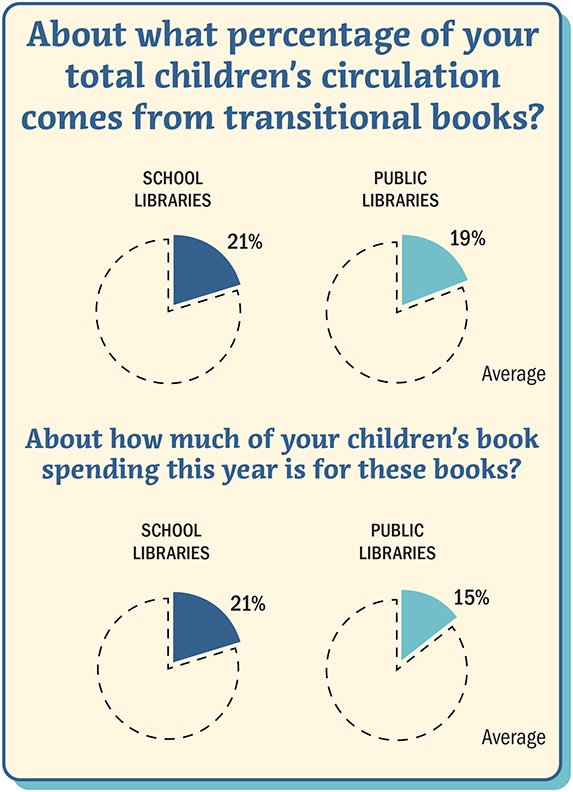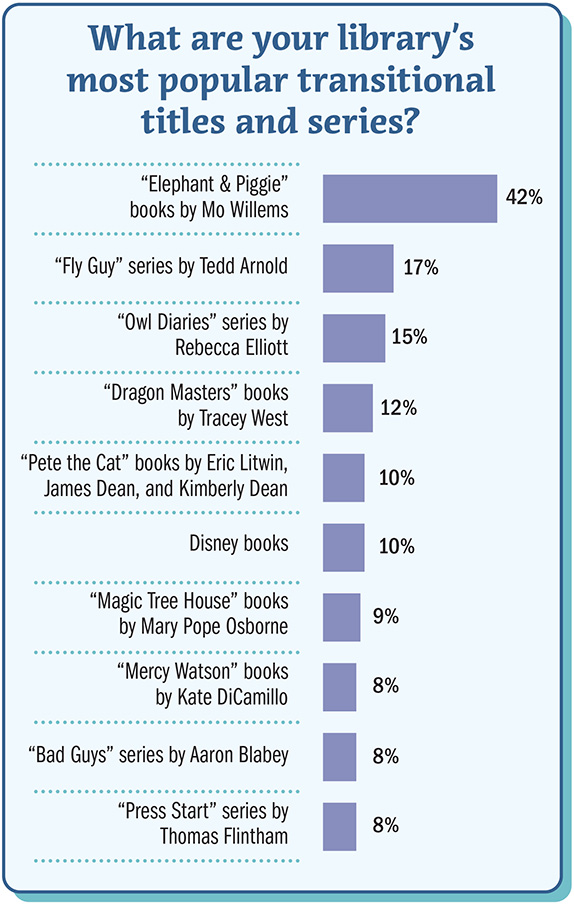New Trends in Transitional Books
Early chapter books? Easy readers? Whatever you call them, transitional books are key for young students, librarians say.
Also read: |
Transitional books are in transition. To bolster these books’ appeal for emerging and newly independent readers, librarians are changing what they call them and how they shelve them, according to respondents to SLJ ’s 2024 Transitional Books Survey.
And since an increasing number of transitional books are graphic novels, librarians are figuring out where to shelve those titles. With prose books? Other graphic novels? There are various solutions.
What makes a good transitional title? The 716 respondents—337 elementary/early school librarians and 379 public librarians—had varying opinions. But transitional books are a solid component of children’s book circulation, averaging about 21 percent in  school libraries and 19 percent in public libraries. School libraries spend more on transitional titles—about 21 percent of their budgets—than public libraries (about 15 percent).
school libraries and 19 percent in public libraries. School libraries spend more on transitional titles—about 21 percent of their budgets—than public libraries (about 15 percent).
These books serve an important purpose, respondents said: to help bolster children’s image of themselves as readers. “The kids like books that make them feel like they are reading harder books,” said Julie Fischer, library media specialist at La Patera Elementary School in Goleta, CA. “Mine seem to love a chapter book that is easy enough for them to read.”
Books for emerging or newly independent readers can be difficult to pin down. Part of the issue is that the books appeal to multiple grade levels. Mainly, first graders read them, respondents said—94 percent and 98 percent at school and public libraries, respectively. Second graders were the next largest group of readers at school libraries (87 percent), while kindergartners came in second at public libraries (92 percent). Significant percentages of third graders and preschoolers also read them.


What to call them?
Worried that terms such as “easy” are a turnoff to children, 29 percent of school libraries and 23 percent of public libraries have changed their term for transitional books from “easy readers” to “early readers.” “Early chapter books” and “early readers” are the preference among 45–46 percent of school library respondents. “Easy readers” is still used by 49 percent of public libraries, with “early readers” used by 44 percent.
“The term ‘easy’ is out of favor,” said Elisha Brookover, librarian at Stearley Primary School on a U.S. military base in Okinawa, Japan. “I use ‘emergent’ and ‘early’ when talking to adults, and I use ‘show off books’ when talking to students and labeling the actual shelves.”
“We kept ‘easy readers,’ but the short chapter books are now called ‘Bridge Books,’ as [children] bridge from easy to chapter book,” said Caitlin Augusta, head of children’s services at Stratford (CT) Library.
“About five years ago, I noticed that the K–2 audience was really drawn to the nonfiction section of the library, so I stopped cataloging nonfiction works as easy readers and assigned them a Dewey number,” said Heather Novotny, librarian at the McGillis School in Salt Lake City, UT.
 “I removed them from fiction with middle grade and created a section called ‘Just Right’ with the abbreviation JR,” added Sarah Logan, teacher-librarian at Dorothy Fox Elementary in Camas, WA.
“I removed them from fiction with middle grade and created a section called ‘Just Right’ with the abbreviation JR,” added Sarah Logan, teacher-librarian at Dorothy Fox Elementary in Camas, WA.
And what about those transitional books being published in graphic novel format? As Nicole Bennett, library media specialist at Sage Canyon Elementary in San Diego, pointed out, “Comics seem to have overtaken transitional chapter books as the next step from picture books and 1/2/3/4 early readers for the majority of readers.”
Fifty percent of respondents said they shelve them with other graphic novels, while 32 percent said they shelve those titles with other transitional books, depending on the book’s targeted age level and reading level. Some respondents were even willing to buy two copies and shelve the titles in both places.
“We decided the patrons who would be looking for those leveled books should only have to look in one place, so we shelve them with our early readers,” said Amy Donnadio, librarian at Scotch Plains (NJ) Public Library.
Some respondents noted the difficulty of determining what counts as a graphic novel and what doesn’t. “For us, comics means both word bubbles and panels. Some of the stuff publishers are calling comics don’t meet that qualification, and they go in with readers instead,” said Becky Standal, youth services librarian at Longview (WA) Public Library.
“Honestly, it’s mostly based on vibes,” said a public librarian in Iowa. “It’ll go in the easy readers if the language is really simplistic and repetitive and/or if it has an early literacy character,” such as Bluey or Elephant & Piggie. “If it takes a little more nuance to understand the story or humor, or if it has more unique art [or a] loose structure, it’ll go in the graphic novels.”
Lauren Knowlton, school media specialist and librarian at Whit Davis Elementary School in Athens, GA, shelves books wherever students will find them most easily. “Graphic novels are so popular that they will definitely get checked out.”
Also read: 9 Standout Early Readers and Chapter Books | SLJ 2024 Stars So Far
Aside from graphic novels and superhero stories, trends in transitional books include mysteries, scary/spooky stories, fantasy, and stories featuring diverse characters. Janet Parker, librarian at Kenwood School in Minneapolis, cited books in which the “main characters are friends or siblings, where one is male and the other female.” She also noted stories with cultural traditions, such as religious holidays and special foods.
Kaitlin Matesich, youth services coordinator at Benzie Shores (MI) District Library, named several trends: “A return to phonics instruction, books that feature similar sounds and spelling patterns are in demand. Horror has also been on the rise in addition to those titles that are folktale- and fairy-tale-based. If there is a dragon, a fairy, a mermaid, or Bigfoot, that book is going to circulate.”
A public librarian in Illinois agreed that children want horror. “The ‘Mister Shivers’ series by Max Brallier fits that gap well, as does the still-in-print Alvin Schwartz title [Scary Stories to Tell in the Dark], but there isn’t much else. ‘Boo Books’ is good for kids who want creepy suspense with a humorous twist, but it doesn’t fill the gap for kids who are going to move up to wanting truly scary and creepy books.”
 In general, humor is the most popular subgenre among transitional readers in school and public libraries (64 and 70 percent). Animal books and licensed character books are next at school and public libraries—at 64 percent and 69 percent, respectively. And 84 percent of respondents say that children prefer series to one-off titles.
In general, humor is the most popular subgenre among transitional readers in school and public libraries (64 and 70 percent). Animal books and licensed character books are next at school and public libraries—at 64 percent and 69 percent, respectively. And 84 percent of respondents say that children prefer series to one-off titles.
Selection criteria
When librarians select transitional books for their collections—a task handled by 93 percent of respondents—they’re looking for specific formats, language levels, book layout, and a variety of characters. For instance, 69 percent of respondents prefer hardcover to paperback if they can afford it. If they think a title might only be briefly popular, though, they’ll opt for paperback.
“If it is a book I know will be circulated a lot, I spend more for hardback,” said Amelia Schenk, librarian at Holy Family Catholic School in Portland, OR.
“Hardcover if it’s a series that maybe puts one book out every couple of years, paperback if it’s a series with more than six titles and at least two to three new titles coming out per year,” said Linda Guzik, library assistant at Glenoaks Elementary School in Glendale, CA.
A school librarian in California broke it down this way: “If it is a transitional picture book, hardcover. Picture books need to be able to take a beating, because they will! If it is a chapter book (or at least, chapter book-sized), paperback is fine and preferred just for the huge difference in price—$25 for a single hardcover or for three $8 paperbacks.”
Other factors respondents take into consideration during selection include child appeal; illustrations; decodable text; familiar or popular characters; diverse characters; and positive reviews, especially starred reviews. Red flags that would disqualify a title include excessive length (83 percent), complex vocabulary (80 percent), or smaller type (73 percent).
“I like when the text is large enough to not feel intimidating but not so large that it feels young,” said Sarah Bean Thompson, youth services manager at Springfield-Greene County (MO) Library. “I look for illustrations, one every page to every two or three pages. Books that are around 100 pages and that are engaging and entertaining stories that parents can read with kids are always important.”
Carrie Munroe, library media clerk at Sylvan STEAM Academy in Modesto, CA, prefers series with animal characters or those that reflect the school population. “I want the vocab to be easy enough for early readers, but enough of a story to keep them reading. I tell them as your brain grows and you read longer books, it might take a few days to finish. Even adults use bookmarks!”
“For the very beginner, rhyming and repetition are very helpful,” said Julie Yekel, children’s librarian at Westchester (IL) Public Library. “For the next step up, familiar characters and culture tie-ins are attractive. For the step before real chapter books, variety is important—they can really handle nonfiction, mysteries, problems, developed characters.”
The value of a transitional book comes down to one question, she adds: “Will this book get kids to read more?”
Download SLJ's 2024 Transitional Books Survey Report.
Marlaina Cockcroft is a writer and editor with a passion for children’s books.
RELATED
The job outlook in 2030: Librarians will be in demand
The job outlook in 2030: Librarians will be in demand
ALREADY A SUBSCRIBER? LOG IN
We are currently offering this content for free. Sign up now to activate your personal profile, where you can save articles for future viewing





Add Comment :-
Be the first reader to comment.
Comment Policy:
Comment should not be empty !!!